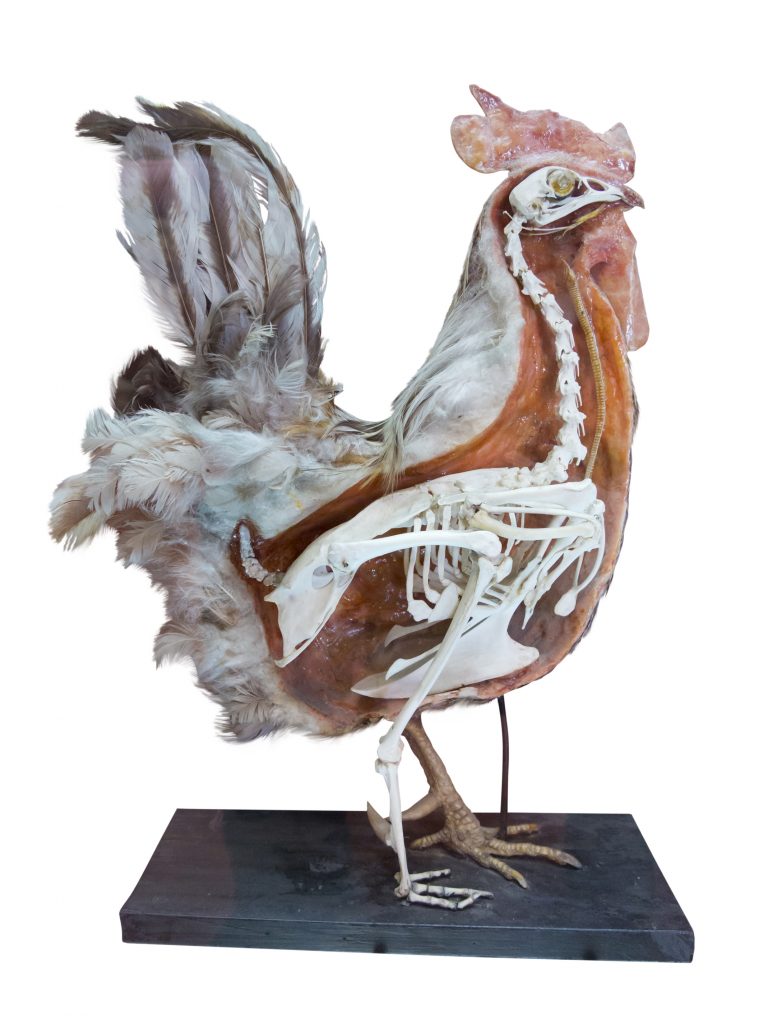written by: dr. jacquie jacob, university of kentucky

all vertebrate animals have skeletons. a skeleton allows an animal to stand and protects its internal organs and tissues. the avian skeletal system looks similar to that of mammals but must accommodate a bird’s need to be light enough to fly while having necessary body support. consequently, the skeleton of a bird includes some unique features.
- some vertebral sections (sections of the backbone) are fused to provide the rigidity required for flight.
- the sternum (breastbone or keel) has a surface area large enough to allow for the attachment of the main flight muscles.
- the size of the skull is proportionally small when compared to the skulls of other species because a large head would make flying difficult.
- the tail is a short section of fused bones called a pygostyle.
- the ribs include the uncinate process, which involves overlying flaps that project from the ribs and connect adjacent ribs, giving strength to the rib cage so that it does not collapse during flight.
- the neck is long in most species. a long, flexible neck acts as a shock absorber, protecting the delicate tissues of the brain from too much jarring when a bird lands. because a bird’s body is rigid, the long neck allows the bird to reach food located on the ground more easily. a long neck also allows a bird’s center of gravity to adjust when the bird changes from the upright position of walking or perching to the more horizontal position of flying.
the bones of birds are lighter in weight than those of mammals. some of the bones are hollow and actually act as part of the avian respiratory system. these bones, called pneumatic bones, include the skull, humerus, clavicle, keel, pelvic girdle, and lumbar and sacral vertebrae.
other important bones in the avian skeleton are the medullary bones. these bones include the tibia, femur, pubic bone, ribs, ulna, toe bones, and scapula. medullary bones are an important source of calcium when hens are laying eggs. eggshells primarily are made of calcium, and a hen’s body mobilizes 47 percent of its body calcium to make an eggshell. when in production, a commercial laying hen cannot obtain enough dietary calcium to allow for daily egg production. without medullary bones to draw calcium from, the hen would produce eggs with very thin and weak shells.
although important differences exist between the skeletons of birds and other animals, several similarities are present as well. in general, birds have the same skeletal structure as many other animals, including humans (as shown in figures 2 and3).
the common joints of the arms of chickens and humans are easily identifiable.
- the joint between the scapula and the humerus is the shoulder.
- the joint between the humerus and the radius/ulna is the elbow.
- the joint between the radius/ulna and the metacarpus is the wrist.
both the human leg and chicken leg have a femur, a fibula, and a tibia. in a chicken, the femur holds the thigh meat, and the fibula/tibia combination holds the meat of the drumstick. the metatarsus of a chicken is known as the shank, and the chicken walks on its toes. a comparison of the leg joints of chickens and humans is not quite as obvious as a comparison of the arm joints.
- the joint at the top of the femur is the hip.
- the joint between the femur and the fibula/tibia is the knee.
- the joint between the fibula/tibia and the metatarsus is the ankle.



